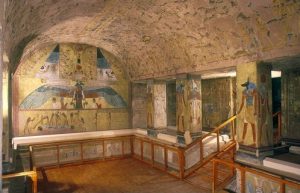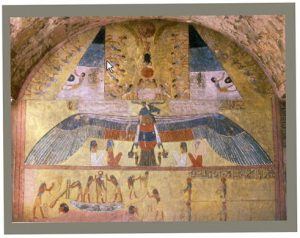
Queen Tawosret (Tawsert) was the Chief Wife of Seti II (of the Nineteenth Dynasty) and her tomb KV14 is located next to that of her husband in the Valley of the Kings, in the Western Bank of Luxor. The tomb is currently open to visitors. Earlier in the Twentieth Dynasty, the tomb was usurped by King Sethnakht who covered the images of Tawosret with plaster over which he painted his own names. Entering the tomb through the entrance, one finds three corridors, the walls of which are decorated with scenes involving relief of the figure of Seti II, the Solar Disc, the scarab, texts from the ‘Book of the Dead’, Depictions of Osiris, Anubis, Ma’at, Hathor, Isis, Re-Horakhty, and an Iun-Mutef priest with the Four Sons of Horus.
A staircase descends through the next room, also decorated with Underworld guardians from the ‘Book of the Dead’, and leads to another series of corridors, decorated with the ‘Opening of the Mouth Ritual’. Here, Anubis is shown tending a mummy on the mummification bed flanked by Isis and Nephthys. The Burial Chamber of Queen Tawosret is of a rectangular plan with eight square pillars decorated with reliefs of numerous gods and goddesses. The chamber's ceiling is decorated with fine astronomical patterns and the walls are ornamented with scenes of the Underworld and others from a number of the Books of the Hereafter, including: the Book of Gates, Book of Earth, and Book of the Caverns. At this chamber, the huge red granite sarcophagus of Sethnakht was found reclining mummiform image of the king on its lid. Sethnakht’s mummy was found in KV35 with the royal mummy cache.

It has been open since antiquity, it was used originally by Tausret and then reused and extended by Setnakht. It was excavated by Hartwig Altenmüller from 1983 to 1987. The tomb is a rare example of a queen's tomb of the Ramesside period in the Valley of the King. Tausret was the wife of Seti II from the 19th dynasty, we are not sure whether she became a pharaoh or not but she was buried in one of the longest tombs in the valley. Her tomb was taken over by Setnakht, the first ruler of the 20th Dynasty and the successor of her husband Seti II. Some scholars believe that Setnakht was to be buried in KV 11, But his son, Ramses III, disagreed and ordered that the body instead be buried in KV 14. In this tomb, there are two complete burial chambers; the first for Tausret and a deeper one for Setnakht. The decoration program of KV 14, begun by Seti II, then by Siptah, then by Tausret, it was changed again, and Setnakht's names now replaced the earlier ones. Figures of Tausret were plastered over, hidden beneath Setnakht's painted cartouches.
- Corridors B, C, D, G, H of the Tomb of Tausret and Setnakht
Corridor B of the Tomb of Tausret and Setnakht: On the left wall of the corridor, the names of the royal figures were changed in the course of the early history of KV 14, but the scenes are still the same and are standard ones of life-size, paired figures of he deceased and deities. On the left wall, offerings of vase are made to Re-Horakhty, food to Anubis, and of a figure of Ma'at to Isis. A figure of Setnakht, carved over one of Tausret, stands before Horus and receives an ankh-sign. On the right wall, the King stands before Ptah, followed by the goddess Ma'at. A second offers to Geb, a third to Ra-Hor-akhty, Hathor, and Nephthys. Corridor C: At the beginning of both the left and right walls of Corridor C, we have badly damaged scenes from Chapter 145 of the Book of the Dead. After that, on the left wall, King Seti II is purified by a figure of Anubis. On the right, Seti II offers to three knife-wielding guardians who stand before the gates of the Netherworld which they protect. On the thicknesses of the gate between Corridors C and D, there are finely painted kneeling figures of the goddess Meretseger. Corridor D: The texts on both walls of this corridor are a continuation of Chapter 145 of the Book of the Dead. The corridor houses some good quality paintings and well-preserved relief. The costumes of the deceased are finely done. Corridor G: Both the right and left wall of Corridor G, mainly show scenes from the Opening of the Mouth ritual. At the beginning of the left wall is the Side Chamber (GA), Chapter 151 of the Book of the Dead decorates the walls of the chamber. The rear wall is showing Anubis tending a mummy, and flanked by goddesses Isis and Nephthys. On the left and right walls, there are figures of two sons of Horus, Anubis, two goddesses, and the deceased. Corridor H: On both sides of the walls of Corridor H, we can see that the scenes of the Opening of the Mouth ritual continue. Other Corridors of the Tomb of Tausret and Setnakht: Moving to Corridors KI, KIA, KID, L, J2, and K2, almost all the decoration in the rear part of the tomb was carved and most of them are badly damaged. These parts of KV 14 are decorated with scenes from the Imydwat and the Book of Gates.
- Chambers E, F, I, J, and J2 of the Tomb of Tausret and Setnakht

Chamber E of the Tomb of Tausret and Setnakht: On the front wall of this chamber, Osiris stands on each side of the doorway. On the left wall stand representations of Imesty, Anubis, Duamutef, and Isis. Horus, Iwnmutef and other two sons of Horus stand on the rear wall. On the right wall stand Hapy, Anubis, Qebehsenuef, and Nephthys. All of the gods in this chamber are dressed in the same way. Chamber F: The texts and Inscriptions on both walls are from Chapter 146 of the Book of the Dead. On the side walls are guardians of the gates of the House of Osiris with heads of birds, a bearded lion, a cobra and a two-headed man. On the rear wall is a double scene of the deceased with Osiris, there was a figure of Tausret here, led to Osiris by Anubis and Horus. Tausret's figure was erased and replaced by a cartouche of Setnakht. This chamber has a central descent through its floor. Chamber I: In the left half of this chamber, there is a beautifully-drawn offering table which was painted to erase the figure of Tausret. On the walls of the chamber, we can see figures of Thoth and Re-Horakhty, Ptah, Osiris, Isis, Nephthys, Horus, Geb, and Ptah, again protected by Ma'at. Figures of the deceased were replaced by blue-painted cartouches of Setnakht. Chamber J: Chamber J is a vaulted burial chamber divided into three parts by two rows of pillars. It is excessively decorated; the right wall and the left end of the front wall are decorated with scenes from the Book of Gates. On the upper part of the left and right wall, we can see scenes from the Book of the Earth. The rest of the right wall is decorated with scenes from the sixth division of the Book of Caverns. The ceiling of the chamber is decorated with astronomical scenes but they are in a bad condition. The scenes around the eight pillars are for the deceased with various deities. Chamber J2 and the Sarcophagus of Setnakht: In the Burial Chamber J2, the sarcophagus of Setnakht sits. It measures 3.25 meters long and is decorated with scenes from the Book of the Earth as well as depictions of various deities.
